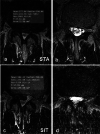The prevalence of redundant nerve roots in standing positional MRI decreases by half in supine and almost to zero in flexed seated position: a retrospective cross-sectional cohort study
- PMID: 36083504
- PMCID: PMC9576640
- DOI: 10.1007/s00234-022-03047-z
The prevalence of redundant nerve roots in standing positional MRI decreases by half in supine and almost to zero in flexed seated position: a retrospective cross-sectional cohort study
Abstract
Purpose: This retrospective cross-sectional cohort study investigated the influence of posture on lordosis (LL), length of the spinal canal (LSC), anteroposterior diameter (APD L1-L5), dural cross-sectional area (DCSA) of the lumbar spinal canal, and the prevalence of redundant nerve roots (RNR) using positional magnetic resonance imaging (MRI) (0.6 T).
Methods: Sixty-eight patients with single-level degenerative central lumbar spinal stenosis (cLSS) presenting with RNR in the standing position (STA) were also investigated in supine (SUP) or neutral seated (SIT) and flexed seated (FLEX) positions. Additionally, 45 patients complaining of back pain and without MRI evidence of LSS were evaluated. Statistical significance was set at p < 0.05.
Results: Controls (A) and patients with cLSS (B) were comparable in terms of mean age (p = 0.88) and sex (p = 0.22). The progressive transition from STA to FLEX led to a comparable decrease in LL (p = 0.97), an increase in LSC (p = 0.80), and an increase in APD L1-L5 (p = 0.78). The APD of the stenotic level increased disproportionally between the different postures, up to 67% in FLEX compared to 29% in adjacent non-stenotic levels (p < 0.001). Therefore, the prevalence of RNR decreased to 49, 26, and 4% in SUP, SIT, and FLEX, respectively.
Conclusion: The prevalence of RNR in standing position was underestimated by half in supine position. Body postures modified LL, LSC, and APD similarly in patients and controls. Stenotic levels compensated for insufficient intraspinal volume with a disproportionate enlargement when switching from the STA to FLEX.
Keywords: Lumbar spine; Positional magnetic resonance imaging; Posture; Redundant nerve roots; Spinal stenosis.
© 2022. The Author(s).
Conflict of interest statement
We declare that we have no conflict of interest.
Figures









Similar articles
-
The prevalence of redundant nerve roots in patients with lumbar spinal stenosis is body position dependent: a retrospective observational study with repeated measures design in an upright MRI scanner.Neuroradiology. 2020 Aug;62(8):979-985. doi: 10.1007/s00234-020-02423-x. Epub 2020 Apr 21. Neuroradiology. 2020. PMID: 32318772 Free PMC article.
-
Conventional Supine MRI With a Lumbar Pillow-An Alternative to Weight-bearing MRI for Diagnosing Spinal Stenosis?: A Cross-sectional Study.Spine (Phila Pa 1976). 2017 May 1;42(9):662-669. doi: 10.1097/BRS.0000000000001889. Spine (Phila Pa 1976). 2017. PMID: 27584675
-
Postural changes of the dural sac in the lumbar spines of asymptomatic individuals using positional stand-up magnetic resonance imaging.Spine (Phila Pa 1976). 2007 Feb 15;32(4):E136-40. doi: 10.1097/01.brs.0000255202.94153.ca. Spine (Phila Pa 1976). 2007. PMID: 17304123 Clinical Trial.
-
The clinical significance of redundant nerve roots of the cauda equina in lumbar spinal stenosis patients: A systematic literature review and meta-analysis.Clin Neurol Neurosurg. 2018 Nov;174:40-47. doi: 10.1016/j.clineuro.2018.09.001. Epub 2018 Sep 4. Clin Neurol Neurosurg. 2018. PMID: 30205275
-
Upright positional MRI of the lumbar spine.Clin Radiol. 2008 Sep;63(9):1035-48. doi: 10.1016/j.crad.2007.11.022. Epub 2008 Mar 12. Clin Radiol. 2008. PMID: 18718234 Review.
Cited by
-
MRI parameters predict central lumbar spinal stenosis combined with redundant nerve roots: a prospective MRI study.Front Neurol. 2024 May 27;15:1385770. doi: 10.3389/fneur.2024.1385770. eCollection 2024. Front Neurol. 2024. PMID: 38859971 Free PMC article.
-
Lumbar spinal stenosis and surgical decompression affect sleep quality and position in patients. A prospective cross-sectional cohort study.Brain Spine. 2024 Mar 22;4:102785. doi: 10.1016/j.bas.2024.102785. eCollection 2024. Brain Spine. 2024. PMID: 39776675 Free PMC article.
-
Can the supine extended position with legs straightened and a lumbar pillow complement the psoas-relaxed position for the diagnosis of lumbar spinal stenosis on MRI? A prospective cross-sectional study.Brain Spine. 2025 Aug 2;5:104377. doi: 10.1016/j.bas.2025.104377. eCollection 2025. Brain Spine. 2025. PMID: 40799618 Free PMC article.
-
Epidural pressure measurement using a fiber-optic sensor (proof-of-principle in vivo animal trial).Animal Model Exp Med. 2024 Oct;7(5):769-776. doi: 10.1002/ame2.12469. Epub 2024 Jul 9. Animal Model Exp Med. 2024. PMID: 38981680 Free PMC article.
References
-
- Hirasawa Y, Bashir WA, Smith FW, Magnusson ML, Pope MH, Takahashi K. Postural changes of the dural sac in the lumbar spines of asymptomatic individuals using positional stand-up magnetic resonance imaging. Spine. 2007;32(4):E136–E140. doi: 10.1097/01.brs.0000255202.94153.ca. - DOI - PubMed
MeSH terms
LinkOut - more resources
Full Text Sources
Medical

